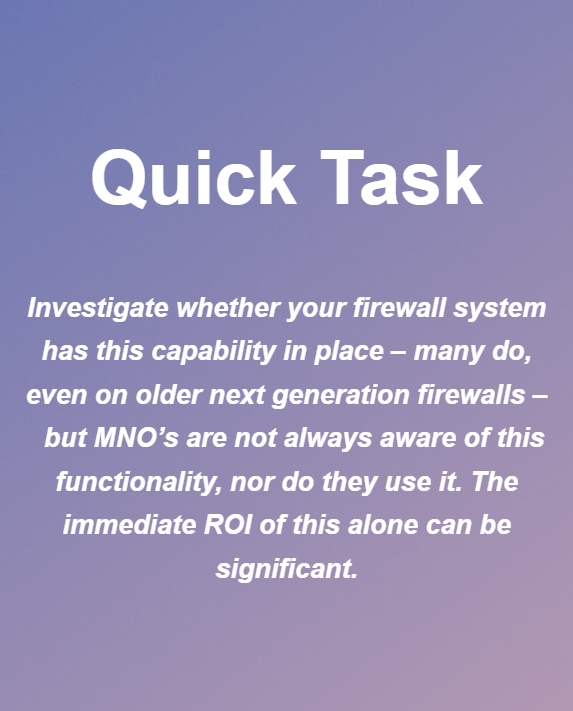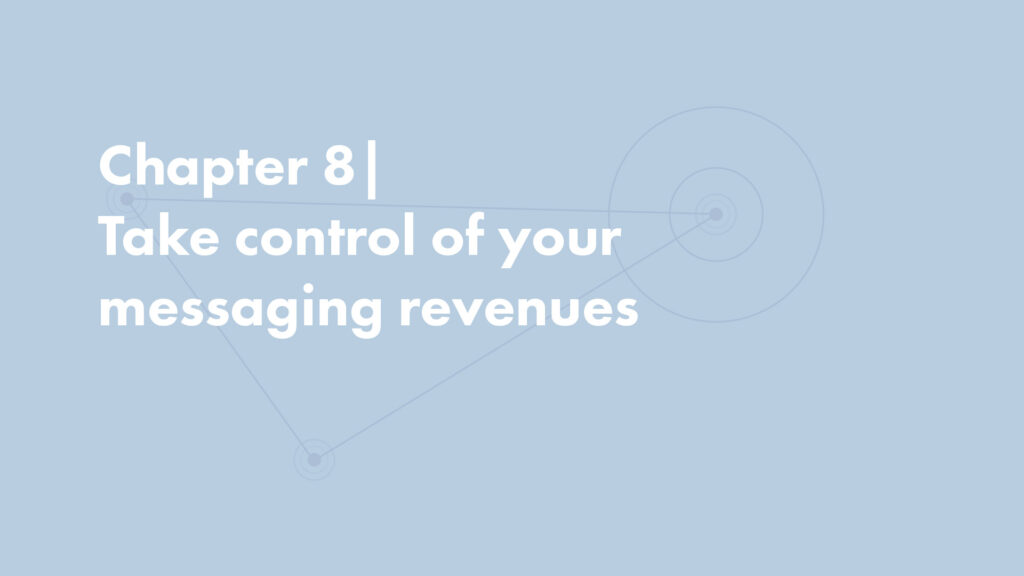
Chapter 7|Revenue Creation
Revenue Creation is really about a couple of things.
Firstly, ensuring you maximise the true market value of the messages you help deliver to end users, and that you utilise a mix of operational and strategic levers to achieve this.
Secondly, it’s about having the capability to invent new business models, build additional relationships, and yet ensure you don’t cannibalize existing revenue streams too heavily.
When it comes to deploying this firewall, there are a few questions we always get asked by MNO’s during discussions with them. We figured it would be helpful to include the most regularly asked here, in line with the ebooks intended purpose of supporting ecosystem growth:
As mentioned, the first step here is managing the complex A2P wholesale vertical of your business as efficiently as possible.
At the start of this ebook, we identified how one creation capability MNO’s can bring in is around flexible pricing. When we were mapping the revenue pinch points, this ability to flex on pricing stood out so clearly, that at HAUD we designed a product specifically to deliver this – but with investment MNO’s could build these tools themselves.
HAUD’s Smart Charge is a rating, charging and traffic management solution that enables MNOs, aggregators and messaging hubs to fully capitalise on A2P traffic by enabling pricing on different parameters for effective revenue generation.

Thanks to the real time visibility your newly installed next generation firewall is delivering, adding in a module like this enables the MNO to optimise the price of a message per:
- Message type: SMS, MMS, RCS, USSD.
- Timing: Differentiated charging based on specific time intervals. (i.e 10am-5pm to 5pm-9pm or overnight)
- Destination: A2P charged by country and/or network combination.
- Category: A2P charged with a combination of brand, message type and criticality.
- Volume: Tiered pricing based on messages sent (volumes) per client.
- Multi-tier Charging: A2P messaging charged through a combination of type, timing, destination, category and volumes per client and supplier connection destination (MCC/MNC).
Differentiation charging is possible on the same connection.
For instance, social network A could be charged $0.10 per (premium) A2P message if it is regarding a security message or 2FA; and $0.03 (regular) for a marketing message or a promotion of any kind.
Additionally, tiered-pricing per client – including price lists differentiation based on volume, time-interval, country, and network – and a combination thereof – are an integral part of the product which provides highly elaborate, but easy to affect, charging mechanisms for further revenue generation.
Provided you have the network visibility, bringing in tech solutions to automate the management of pricing can be a straightforward process – again a clear return on investment calculation.
However at this point, it is worth stressing that the process we outlined just now isn’t about cannibalising existing revenue. This is not a tactic that we would advocate using to extract more money from clients for existing messaging.
Instead it’s about instilling a new flexible strategy for pricing across all your operations – reflecting the reality that certain types of messages are more valuable to businesses than others. A 2FA message needs more immediate delivery than, say, a generic marketing message – so just as you might choose a priority postal service over a regular services, so too do messages ‘need’ different service levels.
Flexible pricing enables you to do this in a way that simply wasn’t practical in the past. But because you now have this facility, you can use it to attract additional business – based on, for example, a partner brand’s own customer acquisition program.
Another area where MNO’s can create new revenue – again thanks to the visibility they now have – is through consent-based monetisation of subscriber information.
How? Well with the permission of end users, MNO’s can segment their subscribers based on their interests or needs, generating valuable databases which can be monetized to brands looking to connect with customers around specific themes or sales. Packaged up, the messaging visibility combined with insights around things like engagement and open rates, enables MNOs to construct new use cases for A2P and sell them on.
The second area we wanted to explore after mapping the pinch points and instigating flexible pricing application, was simplifying the operational experience of MNOs around A2P.
The historic issue MNOs have faced around managing complex, time-consuming, relatively low revenue per client, enterprise relationships has centred around resource allocation. Put simply, again, it’s an ROI thing. Can I justify the time spent managing this V the income generated.
The solution is also automation, but with more human-input strategic control. Again, using HAUD’s MRO strategy as the blueprint, we designed a platform that enables direct A2P business opportunities with wholesale or enterprise clients. The platform has to cater for any message format, direct routing, conversion and connections through superior, frictionless A2P gateways.
This kind of platform – again from a guide perspective if you were looking to build it yourself – has to offer some critical functionality if it’s to work.
First stage is the UX and dashboarding. The platform has to provide full reporting on the MNO’s messaging traffic, including real-time throughput data, financial insights, and pricing, with opportunity identification and margin analysis, including intelligent routing based on various conditions such as least cost routing.
This is key, because an AI-powered dashboard is the only way to manage the request volumes and scheduling etc needed to make this operational change cost-effective and light-touch.
Contained within this management tool, the platform also needs to support MNOs (and their partners – which we’ll come onto in a minute) with some specific actions they need to oversee client management.
For example:
- Margin Protection: The system should enable configurable alerts and profitability filters, including negative margin protection. In other words, the system should be doing a lot of the background thinking and checking to ensure the pricing / volume strategies you put into play, are being enforced.
- Routing Engine: You have to be able to automatically route messages across connections and inter-protocol layers using parameters you decide and which maximise speed and security without impacting capacity.
- Automated billing and invoicing: Sounds like a no-brainer, but it’s vital you can reconcile payments across your marketplace for efficient operations.
Again the majority of this is all programmed and monitored automatically with the human element governing strategic decision making, like who to work with directly, or which industry verticals, and where discounts are needed etc.
A2P Enterprise Platform
On an enterprise-level, partner companies also need to be equipped with a highly intuitive dashboard to manage their A2P messaging channel, content, campaigns, A2P monetisation and credit balance.
In-depth reporting is an integral component of the enterprise view of the platform, thereby providing enterprises of any size, whether they are a big, global social network, or a local pizzeria – the same ability to reach out, engage, and maintain an open communication level with their current – or potential customers.
But to do that, they also need:
A2P Gateway
Think of it as a smaller version of the gateways aggregators use to access the network – only this way you as the MNO deploy it for the Enterprise customer, ensuring you keep that crucial visibility and control.
However, it means the customers still maintain the ability to open connections themselves, globally, without any infrastructure requirements.
Operations
An additional layer an MNO needs to drive this strategy home centres around the operational side of your business.
For example by placing firewall visibility at the heart of your A2P monetization strategy, you also enable a position whereby functions within your operations that used to work in silos are instead more deeply collaborative.
Because the firewall dashboard is accessible, with the same data, and in real time, across your organisation, you can fuse together your risk and revenue teams – enabling agile working to build new products and services at speed.
The same is true for reporting cycles, which can be slashed by offering real, or near-real, time data analysis – allowing the operator to change parameters in their sales programs to cut losses or boost profitability.
All of this, then, gets us to implementation.
Conclusion – Implementing MRO at PACE
What we have discussed so far amounts to stopping illegitimate traffic, locking down revenue leakage, securing and gaining visibility over the network, alongside creating new use cases, relationships and processes to scale A2P revenue.
The last step for this guide is to summarise the above, and work through in a little more detail the implementation – at HAUD, we call this PACE – standing for Protect; Action; Create and Execute.
PACE in effect ties together all of the above, making it possible for MNO’s to deliver on their optimization strategy in the most effective way.

We have already covered off some of the tactical elements used in PACE – revenue defence through a firewall and revenue creation through flexible pricing, for example.
So really this conclusion is mostly about reiterating the strategy and bringing it into your business.
As we stated at the start, maximising your revenue flows from A2P requires two component parts – revenue defence and revenue creation – coupled with process changes that enable de-siloed working.
On the defence side, it begins with ensuring your firewall capability is able to monitor and categorise traffic in real time so you can start to deploy your other strategic initiatives.
Once you have the firewall tracking, you can then start to identify leakage from the network – for example messages being sent through SIM farms avoiding termination charges. Equally, you can start bundling together fraudulent traffic so it is managed in a centralised way, consolidating your ability as an MNO to protect your end users, and protect your reputation too.
The firewall only works optimally with the right commands, and one of the key things each MNO has to do is actively monitor their firewall solution. This requires dynamic rules to be installed – rules that have to change frequently as attack vectors or spam sources iterate – so that filtering of the traffic is comprehensive and alway up-to-date. As we said above, a firewall is only as good as the people managing it and keeping it up-to-date.
Then, once those rules are in place and you are confidently ‘seeing’ all your network messaging traffic, MNO’s then have to route messaging through the correct connections to minimise friction between the sender and the receiver. However, as we stated above, this routing also empowers the operator to start actively managing elements like cost and timing – the start of the revenue creation workflow.
The last aspect to draw out here is just to reiterate that this whole process has to be an ‘always-on’ service – that continual analysis and testing of routes for vulnerabilities and anomalies is an absolute MUST. For example, if you as an MNO set a rule where SIMS sending 30 SMSs in less than an hour are flagged as suspicious, then the grey route operators will shift to 29 messages – in other words, dynamic monitoring is a prerequisite.
The MNO’s ability to optimise their revenue from A2P demands a hands on approach – but while this may seem like expensive outlay, the ROI from driving closer monitoring onto your network is substantial. On average, A2P leakage globally is between 20-30% – so a simple step here can immediately bring in additional revenue.
What’s more, by opting for a revenue share model with a managed next gen firewall provider, MNO’s can avoid any upfront capex costs and just start securing additional revenue from additional traffic.
Moving onto creation – one of the first areas we identified above was the need for better data and analysis. The messaging traffic you as the MNO are now categorizing should be investigated to ascertain both whether you could and should be generating more revenue from it. But equally, that same analysis ought to be able to tell you whether there are gaps in the traffic you handle, which equates to missed opportunities.
Some of those missed opportunities, again as we highlighted, will stem from pricing some potential customers out of the market – so here the suggested solution from our MRO strategy is to introduce flexibility around pricing (and the ability to do it) into your A2P management strategy.
This flexibility in pricing can stem from the customer itself – helping them take advantage of A2P to grow their business – by lowering entry pricing. Or, it can stem from flexibility around the message itself – reduced prices depending on the content, time of sending, destination and volumes etc.
Finally, for HAUD anyway, there is the need to build automation into as many of the MRO processes as possible so the revenue V cost equation is tipped heavily in favour of the former. With your firewall categorising, and your various onboarding and pricing strategies in play, your systems should be able to identify where and when you are failing to meet margin targets you have set. Again, this is a pure play monetization strategy where you as the network operator take fair and appropriate steps to maximise your returns. If there is, for example, greater appetite amongst your A2P customers to send certain types of messages at certain times – then you should be adjusting pricing to reflect this sought-after volume.
The same automation rules should also apply to routing – with your systems able to identify optimal traffic routes without either needing your involvement or impacting on friction levels with other customers, or your trusted wholesale aggregator partners.
Next Chapter

In the final chapter we recap all things MRO ensuring you are ready to create your very own Messaging Revenue Optimisation.

Want to find out more?
Speak with one of our messaging revenue specialists